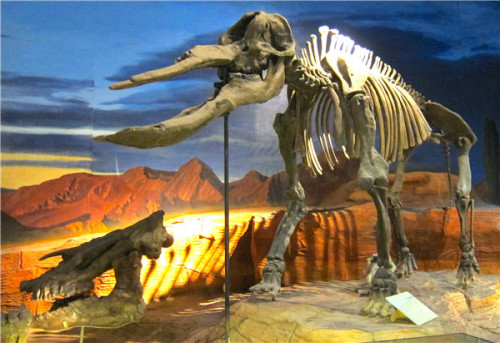
Turpan Museum houses mummies and prehistoric animal skeletons as well as the country's most celebrated archeological displays. (Photo by Erik Nilsson/China Daily)
In a sense, they're the living dead.
Silk Road-era Turpan "left us the largest amount of ancient corpses of various ethnic groups and countries in a single place", the intro says.
The oldest lived 3,200 years ago. The youngest died in the Qing Dynasty (1644-1911).
The Subeixi (third-fifth centuries AD) mummies' hands are adorned with geometric tattoo patterns. Experts point out that their burial attire is akin to that from the same time in southern Siberia.
This display is just hands-as in crinkled, disembodied ones.
Think Thing, of Addams Family fame. Then think creepier.
The Xinjiang Uygur autonomous region's second-largest museum, at 10,000 square meters-including 4,200 square meters presenting nearly 7,000 collections-paints Turpan's Silk Road heritage as a mosaic of peoples.
The litany of populaces is a lot to wrap one's tongue-let alone mind-around.
The five main Silk Road civilizations are the Greco-Roman, ancient Chinese, Indian, Persian-Arabian and nomadic Eurasian steppe cultures.
During the era, the Turpan Basin hosted Cheshi, Han, Hun, Tocharian, Turkic, Tibetan, Uygur, Mongolian and Indian denizens and sojourners.
They left a legacy of shamanism, Buddhism, Zoroastrianism, Manichaeism, Christianity, Islam and Confucianism-not to mention enough languages to overstock a Tower of Babel.
The area today is home to Uygur, Han, Hui, Kazak, Tujia, Manchu, Tu, Tibetan, Miao, Zhuang and Dongxiang ethnicities.
The lists go on.
It's a breathtaking catalog-you can't complete it without taking a breath.
In addition to mummies, skeletons of humans and animals, such as ceremoniously entombed horses, are exhibited.
And fossilized frames of even more primordial beasts, including dinosaurs, rhino ancestors and saber-toothed tigers, prowl an entire hall.
They show the area produced prehistoric biodiversity before it sired historical human variety.
The prefecture's modern multiplicity of cultures is poised to proliferate with the ancient Silk Road's ongoing revival, though sightings of cannabis-puffing necromancers are unlikely.
Perhaps it will conjure something more magical.
















































